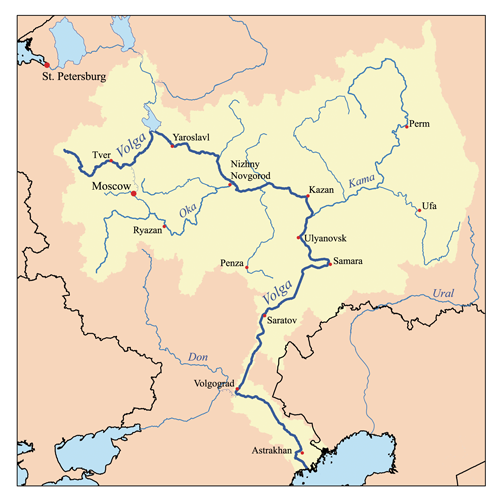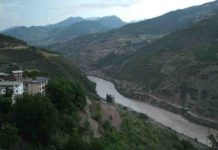
The Volga is the longest river in Europe; it is also Europe’s largest river in terms of discharge and watershed. It flows through central Russia and is widely viewed as the national river of Russia. Eleven of the twenty largest cities of Russia, including the capital, Moscow, are situated in the Volga’s drainage basin. Some of the largest reservoirs in the world can be found along the Volga. The river has a symbolic meaning in Russian culture and is often referred to as Volga-Matushka (Mother Volga) in Russian literature and folklore.
Nomenclature
The Russian hydronym Volga (Волга) derives from Proto-Slavic *vòlga “wetness, moisture”, which is preserved in many Slavic languages, including Ukrainian volóha (воло́га) “moisture”, Russian vlaga (влага) “moisture”, Bulgarian vlaga (влага) “moisture”, Czech vláha “dampness”, Serbo-Croatian vlȁga “moisture”, and Slovene vlaga “moisture” among others.
The Slavic name is a loan translation of earlier Scythian Rā (Ῥᾶ) “Volga”, literally “wetness”, seen also in Avestan Raŋhā “mythical stream” and Sogdian r’k “vein, blood vessel” (*raha-ka), and cognate with Sanskrit rasā́h “liquid, juice; mythical river”. The Scythian name survives in modern Mordvin Rav (Рав) “Volga”.
The Turkic peoples living along the river formerly referred to it as Itil or Atil “big river”. In modern Turkic languages, the Volga is known as İdel (Идел) in Tatar, Атăл (Atăl) in Chuvash, Idhel in Bashkir, Edil in Kazakh, and İdil in Turkish. The Turkic peoples associated the Itil’s origin with the Kama River. Thus, a left tributary to the Kama River was named the Aq Itil “White Itil” which unites with the Kara Itil “Black Itil” at the modern city of Ufa. The name Indyl (Indɨl) is used in Adyge (Cherkess) language.
Among Asians the river was known by its other Turkic name Sarı-su “yellow water”, but Mongols also used their own name: Ijil mörön “adaptation river”. Presently the Mari, another Uralic group, call the river Юл (Jul), meaning “way” in Tatar. Formerly, they called the river Volgydo, a borrowing from Old Russian.
Description
The Volga River is the longest river in Europe. It belongs to the closed basin of the Caspian Sea. Rising in the Valdai Hills 225 meters (738 ft) above sea level northwest of Moscow and about 320 kilometers (200 mi) southeast of Saint Petersburg, the Volga heads east past Lake Sterzh, Tver, Dubna, Rybinsk, Yaroslavl, Nizhny Novgorod, and Kazan. From there it turns south, flows past Ulyanovsk, Tolyatti, Samara, Saratov and Volgograd, and discharges into the Caspian Sea below Astrakhan at 28 meters (92 ft) below sea level. At its most strategic point, it bends toward the Don (“the big bend”). Volgograd, formerly Stalingrad, is located there.
The Volga has many tributaries, most importantly the Kama, the Oka, the Vetluga, and the Sura rivers. The Volga and its tributaries form the Volga river system, which flows through an area of about 1,350,000 square kilometres (521,238 square miles) in the most heavily populated part of Russia. The Volga Delta has a length of about 160 kilometres (99 miles) and includes as many as 500 channels and smaller rivers. The largest estuary in Europe, it is the only place in Russia where pelicans, flamingos, and lotuses may be found. The Volga freezes for most of its length for three months each year.
The Volga drains most of Western Russia. Its many large reservoirs provide irrigation and hydroelectric power. The Moscow Canal, the Volga–Don Canal, and the Volga–Baltic Waterway form navigable waterways connecting Moscow to the White Sea, the Baltic Sea, the Caspian Sea, the Sea of Azov and the Black Sea. High levels of chemical pollution have adversely affected the river and its habitats.
The fertile river valley provides large quantities of wheat, and also has many mineral riches. A substantial petroleum industry centers on the Volga valley. Other resources include natural gas, salt, and potash. The Volga Delta and the nearby Caspian Sea offer superb fishing grounds. Astrakhan, at the delta, is the center of the caviar industry.
Note : The above story is based on materials provided by Wikipedia










